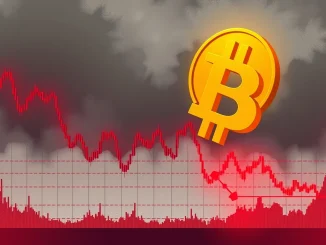
The past 24 hours have sent significant ripples across the cryptocurrency market, witnessing a staggering $376.24 million in crypto liquidations across various perpetual futures contracts. This massive wipeout highlights the inherent volatility and risks of leveraged trading, catching many participants off guard. Understanding these events is crucial for anyone navigating the digital asset space.
Understanding Crypto Liquidations and Perpetual Futures: What Are They?
Before diving into the numbers, let’s clarify what we’re discussing. Perpetual futures are a type of derivative contract that allows traders to speculate on the future price of a cryptocurrency without actually owning the underlying asset. Unlike traditional futures, they have no expiry date, making them popular for continuous trading.
A liquidation occurs when a trader’s leveraged position is forcibly closed by an exchange due to insufficient margin to cover potential losses. This typically happens when the market moves sharply against a trader’s position. For instance, if you’re long (betting on price increase) and the price drops significantly, or if you’re short (betting on price decrease) and the price rises sharply, your position might be liquidated. These events can trigger a cascade, amplifying market movements.
The Devastating 24-Hour Crypto Liquidations Breakdown
The recent 24-hour period saw a substantial sum wiped out from leveraged positions. Here’s a detailed breakdown of the total crypto liquidations:
| Asset | Liquidated Value | Short Positions Liquidated |
|---|---|---|
| ETH | $208.94 million | 66.12% |
| XRP | $87.50 million | 76.91% |
| BTC | $79.80 million | 74.25% |
The total sum liquidated stands at approximately $376.24 million. A striking observation is the high percentage of short positions liquidated across all three major assets. This indicates that a sudden upward price movement caught many traders betting on a decline off guard, leading to forced closures of their short positions.
Ethereum Liquidation: Why Did ETH Lead the Pack?
Ethereum (ETH) accounted for the largest share of liquidations, with a staggering $208.94 million wiped out. Over 66% of these were short positions. This suggests a strong, perhaps unexpected, upward price surge for ETH that caught short sellers off guard. Factors contributing to significant Ethereum liquidation could include:
- Positive developments or anticipation around Ethereum’s network upgrades.
- Increased institutional interest or significant whale movements.
- A broader market rally where ETH outperforms other major assets.
The sheer volume of ETH liquidations underscores its sensitivity to market shifts and the high leverage often employed in its perpetual futures.
XRP Liquidation: A Significant Blow to Short Sellers
XRP saw $87.50 million in liquidations, with an even higher percentage of short positions at 76.91%. This indicates a particularly aggressive move against traders betting on XRP’s decline. The high short liquidation rate for XRP liquidation could be influenced by:
- Positive news regarding its ongoing legal battles or regulatory clarity.
- Sudden positive sentiment shifts within the XRP community.
- Specific market events that favor XRP’s price action, leading to a swift price pump.
The high percentage of short liquidations in XRP suggests a strong short squeeze, where a rapid price increase forces short sellers to buy back, further fueling the price rally.
Bitcoin Liquidation: BTC’s Role in the Broader Market Cascade
While not the highest in this 24-hour period, Bitcoin liquidation still accounted for a substantial $79.80 million, with over 74% being short positions. Bitcoin (BTC) often acts as the market’s bellwether; its movements typically influence the broader altcoin market. Even if its liquidation total was lower than ETH’s, BTC’s price action often sets the tone for other assets. A significant rise in BTC’s price can trigger a ripple effect, leading to liquidations across the board as traders adjust their positions or get caught in cascading events.
What Does This Massive Liquidation Event Mean for Traders?
These significant perpetual futures liquidations offer crucial lessons for all traders, especially those engaging in leveraged trading:
Volatility is Constant: The crypto market is inherently volatile. Price swings can be sudden and dramatic, making leveraged positions extremely risky.
Risk Management is Paramount: Always use stop-loss orders to limit potential losses. Never over-leverage your positions. Understand that even small price movements can lead to liquidation if your leverage is too high.
Beware of Short Squeezes: When a large number of short positions are open, a sudden upward price movement can trigger a short squeeze, forcing short sellers to buy back and further driving up the price, leading to more liquidations.
Diversify and Research: Do not put all your capital into highly leveraged positions. Conduct thorough research before entering trades, understanding both the fundamental and technical aspects of the assets.
Conclusion: Navigating the Volatile Crypto Landscape
The past 24 hours serve as a stark reminder of the immense risks and rewards present in the crypto perpetual futures market. The nearly $376 million in crypto liquidations, heavily skewed towards short positions, highlights how quickly market sentiment can shift and punish over-leveraged traders. While perpetual futures offer opportunities for significant gains, they demand extreme caution, robust risk management strategies, and a deep understanding of market dynamics. As the crypto space continues to evolve, prudence and informed decision-making remain your strongest allies against such devastating market events.
Frequently Asked Questions (FAQs)
What are crypto liquidations?
Crypto liquidations occur when an exchange forcibly closes a trader’s leveraged position because their margin balance falls below the required maintenance margin. This happens when the market moves against their position, and they no longer have enough collateral to keep the trade open.
What are perpetual futures in cryptocurrency trading?
Perpetual futures are a type of derivative contract that allows traders to speculate on the price of a cryptocurrency without an expiration date. Unlike traditional futures, they don’t settle physically or expire, making them popular for continuous trading and speculation on price movements.
Why were short positions primarily liquidated in this event?
The high percentage of short positions liquidated (over 66% for ETH, 76% for XRP, and 74% for BTC) indicates that the market experienced a sudden upward price movement. Traders who were betting on prices to fall (shorting) were caught off guard, leading to their positions being forcibly closed as prices rose, often triggering a ‘short squeeze’ effect.
How can traders avoid liquidation when using perpetual futures?
To avoid liquidation, traders should implement strict risk management strategies, including: using appropriate leverage, setting stop-loss orders to limit potential losses, maintaining sufficient margin in their accounts, and avoiding over-exposure to highly volatile assets.
Does a large liquidation event mean the crypto market is crashing?
Not necessarily. While large liquidations indicate significant volatility and potential pain for some traders, they don’t always signify a market crash. In this case, the high percentage of *short* liquidations suggests a sharp upward price movement (a short squeeze) rather than a market downturn. It highlights market instability but not necessarily a bearish trend.



